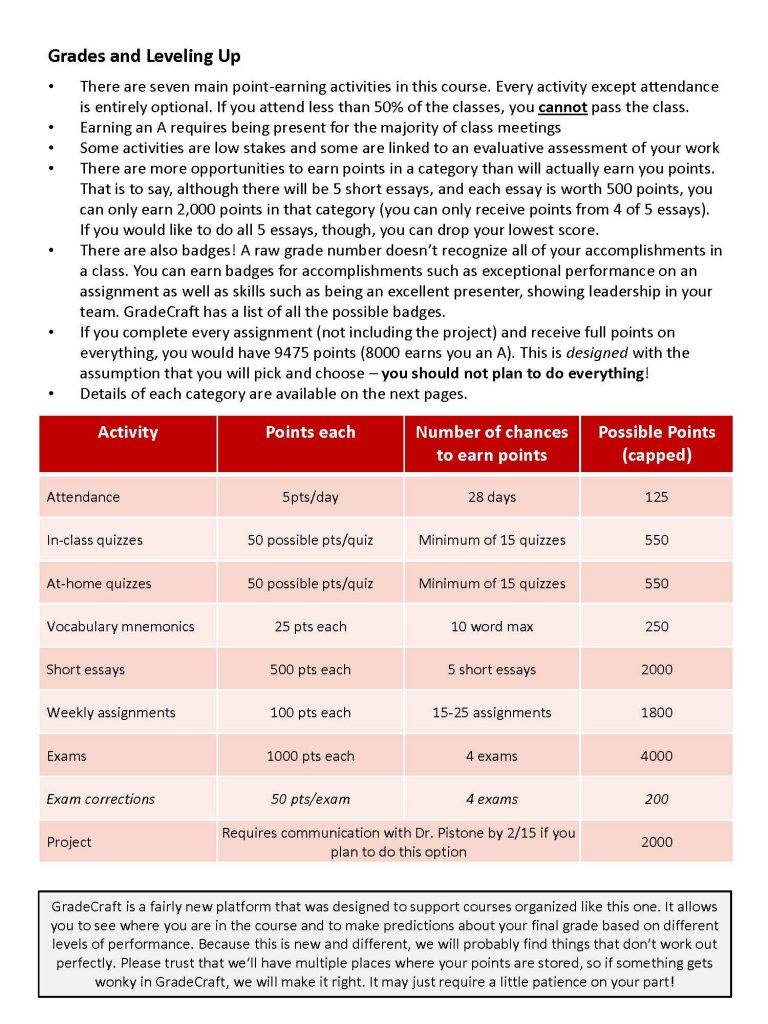First of all, here’s a post about what gameful course design even is.
I used the GradeCraft platform, something I’d learned about when I was a grad student at Michigan (where it was developed and also). The platform can be its own LMS (Learning Management System) but it can also integrate with other systems. I don’t know if it’s necessarily better than other options, though I did think the support for GradeCraft was really exceptional. They were responsive and very receptive to feedback about what would improve the platform in the future.
In Spring 2019, I was assigned to teach The Greek and Latin Roots of Medical Terminology, a class I’d never taught before, nor had I ever given much thought to teaching. As I shared with my students (aggressive transparency is going to be a theme here), I honestly wasn’t that sure why someone would take a class that was mostly about memorizing word parts — they could just buy a book or Google a list of terms, and they didn’t really need me for that. Given that I hadn’t taken a biology class since the year 2000, I was nothing close to an expert on the things described by these Greek- and Latin-derived roots, but I also didn’t think I could spend 150 minutes a week helping them memorize word parts, so I was at a bit of a loss.
With that in mind, I wanted to try some new and different things with the class, both pedagogically and in terms of course content. Part of the changes I wanted to make to the course content involved adding in more ancient medicine and bits of medical humanities. At the same time, I knew that wasn’t what the students signed up for. This tension was part of reason I thought a gamified class structure would be a good option, because of the element of student choice it introduces into a class structure. No one would be required to do all the assignments or readings, and students could focus on the things that were most important to them and what they wanted to get out of the class.
Also, I wasn’t sure how many students would be taking the class for a grade, as opposed to pass/fail, and another nice element of this class structure is that it’s similar to contract grading and students can do the amount of work they need to do for the grade they want to get. If they want an A, they know what they have to do. If they want a C, they know what they have to do.
The Platform
Definitely check out GradeCraft more, because there’s a lot there, but there are a few elements that were extra useful. This was the information I gave my students about how the points worked:

This would have been an incredible amount of work to manage and limit manually, but GradeCraft allowed me to just put in the details, and it managed it all for me.

Finally, it also includes a grade predictor (though some students struggled to get it to work well for them) and it let me award fun badges to give students extra recognition for doing great work!

What Went Well
Overall, this was a success! I asked my students if they would recommend that I use the GradeCraft platform for another class, and the results were pretty positive! 62.5% said Yes, 37.5% said “Yes but with some changes,” and 0% said No.
After the course was basically over, I asked my students for feedback on what they thought about the platform (not my execution of it) and it seems like this design met my goals for my students and the class really well. Earning points instead of losing points seems to have really helped a lot of them think differently about trying things and taking chances. The element of choice that was built into the class allowed students to put their energy into the parts of the class that they were most interested in. This student really summarized it nicely: “I think this type of grading system would be difficult in more straightforward classes, but for how broad this class was and the amount of material we covered I think it was the perfect way to go about doing it for each student to be able to individualize the type of class they wanted from this. If someone wanted more of a ‘memorize the terms’ class they could mainly just do quizzes and exams and be fine, but other students may be more interested in the creative writing of the essays or explorations of the reading responses each week.”
The other thing that came through in student feedback was how much they appreciated the schedule flexibility that the element of choice introduced. Students could choose to do assignments based on what they were most interested in, but they could also make choices based on the deadlines. If they had a busy week in their other classes or had other commitments outside of school, they could skip an assignment without it hurting their grade. This seemed to have a really positive effect on their general stress as well. Here are a few more things from the student feedback:
- “I love the idea of having students choose what they do to earn points because some weeks are crazier than others. Also it’s very positive and that outlook of not being punished or losing points but also gaining them is so much better for stress and our mental health.”
- “It made the class feel much more laid back. Didn’t feel stressed about every assignment but did them anyways out of habit.”
- “I really liked the GradeCraft format and being able to earn points instead of feeling “punished” for losing points on assignments. With the normal grading system, you are required to do all the various types of assignments fully – having the option to choose which assignments to do that work best with your learning style (and fits how much effort one wishes to put into a class), made learning seem more fun and more tailored to what I as the student wanted to do. I think it made me more willing to do the assignments that I knew helped me learn instead of them feeling like a chore or another ‘to do’ thing just to get the completion points.”
- “I think it is a great idea. Every little thing I had the mindset it was helping me and was worth it rather than that it hardly mattered or would bring my grade down.”
- “I really liked it and I thought you taught well, and I enjoyed this class design very much overall. I liked the freedom of being able to choose which assignments to do; I’ve never had that in a class before. (I mean, I’ve chosen not to do assignments before, but not with the professor’s permission.)”
What Went Not-So-Well
This sort of class design would really go more smoothly if the class was fully scheduled and planned in advance. Because this was the first time I’d taught this class, and because I wanted to tailor the class to what the students needed and wanted, I was adding weekly readings and responses throughout the semester. This meant that I could give students guarantees about the points I would make available, but they didn’t really have the full roadmap for the class in advance. This is really something I would do a better job of the next time around. I wasn’t prepared for some of the scheduling elements of this class and it meant that students had less of an idea what to expect, though I did try to make up for this by being very transparent with communication.
Student comments were almost all variations of “I really wish we’d known all the available assignments and points in advance,” which I completely understand. There were some concerns about the speed of the platform (the integration with our LMS wasn’t as smooth as it might have been) and responses were about 50-50 in terms of whether the Grade Predictor function worked well for people.
- “I definitely think there was a fear as we went on in the semester and many of us were still in the ‘F’ range. If there was somehow a way to change that rhetoric, that would be nice.”
- “I think the biggest challenge was to figure out what I could and could not do to still get the grade I wanted. Like in the beginning, I was afraid not to do an assignment because I may need the points later.”
Other Student Feedback
A lot of student comments were variations of this one (and yes, I’m vain enough not to cut out that first exclamation): “I love how you taught! Just maybe put all the opportunities to get points up ahead of time so that the grade predictor could be more accurate (I know that’s more work for you upfront though) and I really appreciate you adjusting the points at the end and reassuring us throughout.” This seems imminently fair on all fronts, and I do think that my students were more willing to put up with what was a very trial-and-error process specifically because I spent a lot of time trying to reassure them that they were not going to fail. Another very common sentiment (echoing some of the comments above) was “It would have been nice to have had all of the weekly assignments uploaded at the beginning of the semester. That way, it would have been easier to pick and choose which ones to do. I felt like I had to do each one because I wasn’t sure how many more would be left to be able to get the number of points I wanted to.” Again, I think my students were more understanding of this because I made it very clear that I was trying something new and I appreciated them trying this out with me.
Last Thoughts
Originally, I was thinking about using this kind of design for my Greek 1 class this coming semester, and I ultimately opted not to. While I loved a lot of the things that GradeCraft and a gamified class offered, I didn’t that this particular model/platform was a good fit for my learning objectives in a beginning language class. While I think that giving students choice and flexibility is a great thing to do, my learning objectives for a language class are very different than for a class like a Medical Etymology class. A beginning language class involves a lot of “lower level” learning objectives (Learning and Comprehension in Bloom’s Taxonomy), in that there are a lot of things students need to memorize in order to succeed in later language classes. In terms of content, I want my students to have a full toolbox of Greek skills, which means that they can’t opt out of certain elements of the class.

That being said, a lot of the strengths of this particular class designs are things that I try to do in all my classes. Low stakes assignments and schedule and assignment flexibility are things I build into all my syllabi, regardless of what sort of platform I’m using. There are also a lot of ways that a gameified philosophy, so to speak, can help shape my pedagogy more generally.


no replies